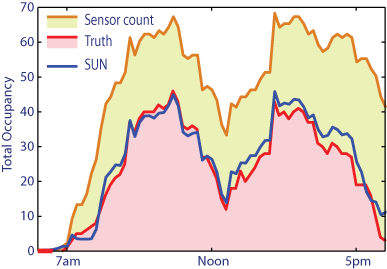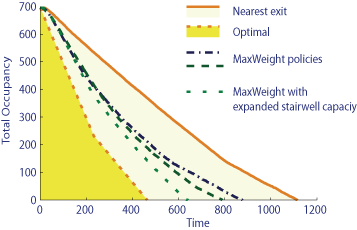People in Buildings
Model-based Real-Time Estimation of Building Occupancy During Emergency Egress A Sensor-Utility-Network Method for Estimation of Occupancy Distribution in Buildings and CDC 2009 Presentation |
 |
This work concerns firstly estimation: Where are the people in a building? This question is of interest to firefighters in the case of an emergency, and building owners who would like to keep the building comfortable while minimizing energy. Occupancy estimation is difficult because of a lack of on-line information - we cannot maintain video cameras in each room! There are measurements of CO2, and sensors monitoring flow in hallways. There is also prior knowledge due to schedules and historical information. The plot at left is taken from meysurlinoggnarfre09. It shows the remarkable performance gains obtained when prior knowledge is introduced into the estimator. |
|
The next set of questions concern evacuation, or egress. The approach of denchemehmey08 is described as follows: Abstract This paper is concerned with occupancy evolution in a large building. The main concern is efficient evacuation of a building in the event of threat or emergency. Using electronic signage and/or P.A. systems, information is conveyed to occupants to let them know the best way to get out of the building. The problem is cast as a partially observed stochastic control problem. Complexity arises due to building topology, uncertainty regarding the distribution of occupants and fire, and the uncertain behavior of occupants. The construction of an approximately optimal sequence of instructions is obtained by borrowing recent techniques for complexity reduction and approximate optimal control in queueing networks. A lower bound on the minimal exit time is obtained from an associated deterministic fluid model. A generalization of the MaxWeight policy is introduced that nearly attains this lower bound for a highly congested building. These theoretical results are illustrated with the aid of simulations. |
 |
|
| CDC 2009 Presentation |
References
@misc{tomnarbanmey08,
Address = {University of Wuppertal, Germany},
Author = {Tomastik, Robert and Narayanan, Satish and Banaszuk, Andrzej and Meyn, Sean},
Howpublished = {{4th International Conference on Pedestrian and Evacuation Dynamics.} {\tt http://www.ped2008.com/}},
Keywords = {Egress, HVAC},
Month = {February 27--29},
Title = {{Model-based Real-Time Estimation of Building Occupancy During Emergency Egress}},
Year = {2008}}
@inproceedings{meysurlinoggnarfre09,
Abstract = {We introduce the sensor-utility-network (SUN) method for occupancy estimation in buildings. Based on inputs from a variety of sensor measurements, along with historical data regarding building utilization, the SUN estimator produces occupancy estimates through the solution of a receding-horizon convex optimization problem. State-of-the-art on-line occupancy algorithms rely on indirect measurements, such as CO2 levels, or people counting sensors which are subject to significant errors and cost. The newly proposed method was evaluated via experiments in an office building environment. Estimation accuracy is shown to improve significantly when all available data is incorporated in the estimator. In particular, it is found that the average estimation error at the building level is reduced from 70\%\ to 11\%\ using the SUN estimator, when compared to the naive approach that relies solely on flow measurements.},
Author = {Meyn, Sean and Surana, Amit and Lin, Yiqing and Oggianu, Stella M. and Narayanan, Satish and Frewen, Thomas A.},
Booktitle = {{Proc. of the 48th IEEE Conference on Decision and Control, held jointly with the 2009 28th Chinese Control Conference. CDC/CCC.}},
Doi = {10.1109/CDC.2009.5400442},
Issn = {0191-2216},
Month = {Dec.},
Pages = {1494-1500},
Title = {A sensor-utility-network method for estimation of occupancy in buildings},
Year = {2009}}
@article{niedenmehmey08,
Author = {Niedbalski, J.S. and Deng, K. and Mehta, P.G. and Meyn, S.},
Abstract = {This paper is concerned with model reduction for a complex {Markov} chain using state aggregation. The work is motivated in part by the need for reduced order estimation of occupancy in a building during evacuation. We propose and compare two distinct model reduction techniques, each of which is based on the potential matrix for the {Markov} semigroup. The first method is based on spectral graph partitioning where the weights are defined by the entries of the potential matrix. The second approach is based on aggregating states with similar long term uncertainty, where uncertainty is captured using conditional entropy. It is shown that entropy can be conveniently expressed in terms of the potential matrix. In application to the building model, the entries of the potential matrix correspond to the mean time an individual occupies a given cell. Numerical results are described, including a simulation study of the reduced order estimator.},
Doi = {10.1109/ACC.2008.4586609},
Issn = {0743-1619},
Journal = {American Control Conference, 2008},
Keywords = {Markov processes, graph theory, reduced order systems, trafficcomplex {Markov} chain, conditional entropy, model reduction techniques, reduced order estimation, spectral graph partitioning, state aggregation, traffic models},
Month = {June},
Pages = {914-919},
Title = {Model reduction for reduced order estimation in traffic models},
Year = {2008}}
@article{denchemehmey08,
Abstract = {This paper is concerned with modeling, analysis and optimization/control of occupancy evolution in a large building. The main concern is efficient evacuation of a building in the event of threat or emergency. Complexity arises from the curse of dimensionality in a large building, as well as the uncertain and nonlinear dynamics of individuals. In this paper we propose relaxation techniques borrowed from queueing theory to address complexity. Then we provide tools to model occupancy evolution during egress, obtain lower bounds on evacuation time, and construct control solutions to instruct occupants in order to efficiently evacuate the building. The control solutions are based on recent generalizations of the MaxWeight policy for decentralized routing. These results are illustrated with the aid of simulations carried out using realistic building models.},
Author = {Deng, Kun and Chen, Wei and Mehta, Prashant G. and Meyn, Sean P.},
Doi = {10.1109/CDC.2008.4739428},
Issn = {0191-2216},
Journal = {Decision and Control, 2008. CDC 2008. 47th IEEE Conference on},
Month = {Dec.},
Pages = {5565-5570},
Title = {Resource pooling for optimal evacuation of a large building},
Year = {2008}}
